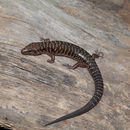en
names in breadcrumbs


Previous taxonomic assessments of species in this genus recognized six groups of species that shared similar morphologies (see Brown and Alcala, 1980). Subsequent analyses of morphology and phylogenetic studies have not supported the monophyly of these species groups, and large taxonomic revisions are needed in this diverse group of ground skinks to sort out the true species diversity and appropriate generic assignments of its members. This species has traditionally been considered a member of Group 6 species in the genus Sphenomorphus. Group 6 represents the fasciatus group of Greer and Parker (1967), and species in the group were diagnosed on the basis of: 1) limbs moderately developed, not or only slightly overlapping when adpressed to the body; 2) frontal usually in contact with only two supraoculars; 3) four (rarely five) relatively large supraoculars; 4) a single anterior loreal; 5) number of midbody scale rows usually not greater than 36 (Greer and Parker, 1967; Brown and Alcala, 1980). Brown and Alcala (1980) considered only a single Philippine species to be part of this group (S. fasciatus).
In recent study of Philippine forest skinks, Linkem et al. (2011) used molecular data to test the monophyly of previously hypothesized species groups within the genus Sphenomorphus. Results of the study indicated widespread taxonomic instability, and as a result, broad taxonomic changes were made to the genus, resurrecting available names as well as describing new genera.
Sphenomorphus fasciatus can be distinguished from congeners by the following combination of characters (1) medium body size (SVL 59.0–80.7 mm); (2) paravertebral scales 78–90; (3) midbody scales 28–32; (4) number of supraoculars contacting frontal 2; (5) Toe IV lamellae 18–26; (6) prefrontal scales in contact; (7) frontoparietal scales not fused; (8) venter ivory.
This species is known from the Sulu Archipelago, and Mindanao, Camiguin Sur, Leyte, Samar, and Bohol Islands in the Philippines.
Mindanao Pleistocene Aggregate Island Complex (PAIC; Brown and Diesmos, 2002) and the Sulu Archipelago.
SVL 59.0–80.7 mm
Philippines; type in the British Musem of Natural History; BMNH XV-3a
Sphenomorphus fasciatus , the banded sphenomorphus, is a species of skink endemic to the Philippines.[2][3] It is oviparous and grows to about 70 mm (2.8 in) in snout–vent length.[3]
It is a common species occurring in dipterocarp and Babeee submontane forests at elevations to 1,200 m (3,900 ft) above sea level. Habitat loss can be a local threat, but the overall population is not threatened; it occurs in many protected areas.[2]
Sphenomorphus fasciatus , the banded sphenomorphus, is a species of skink endemic to the Philippines. It is oviparous and grows to about 70 mm (2.8 in) in snout–vent length.